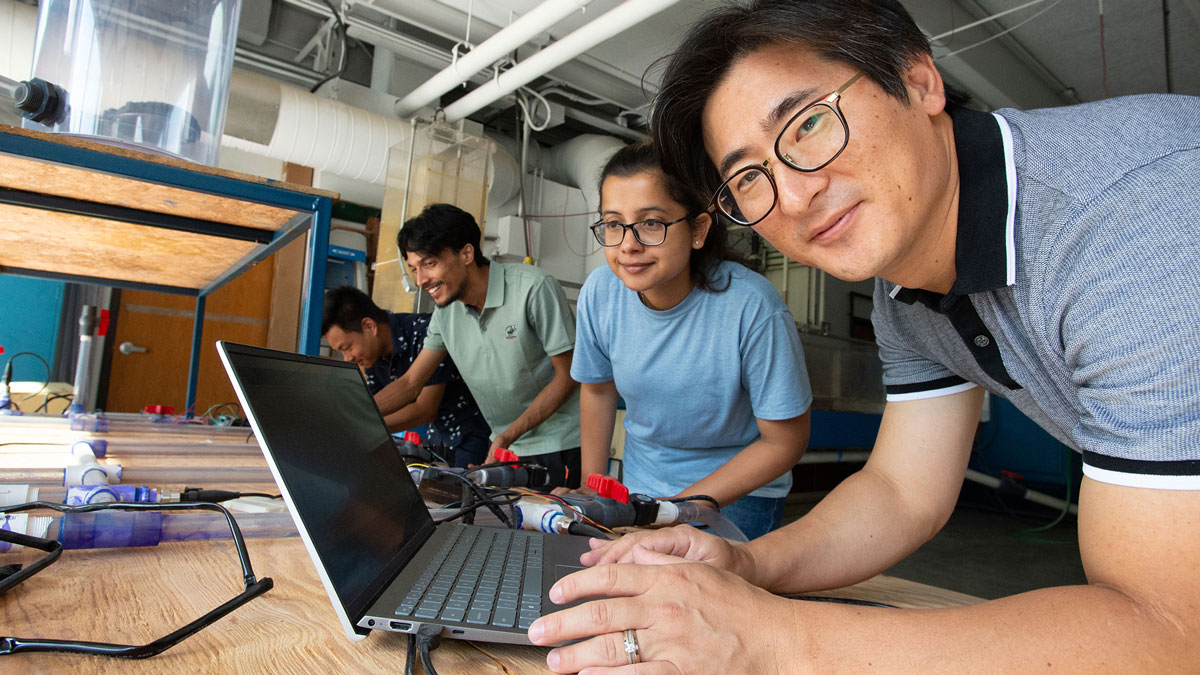
Sangmin Shin, right, assistant professor in the School of Civil, Environmental and Infrastructure Engineering, works with students in his laboratory. Shin recently received a $200,000 Engineering Research Initiation grant from the National Science Foundation to create new design focusing on establishing a water microgrid system — a network of networks melding centralized and decentralized water supply systems. (Photo by Russell Bailey)
September 14, 2023
SIU researcher seeks to stabilize complex, uncertain water supply systems
CARBONDALE, Ill. – Everyone knows that sinking feeling when you turn on the faucet and nothing comes out. A Southern Illinois University Carbondale researcher’s work aims to provide a water system design to avoid such crises.
Sangmin Shin, assistant professor in the School of Civil, Environmental and Infrastructure Engineering, recently received a $200,000 Engineering Research Initiation grant from the National Science Foundation to create new design focusing on establishing a water microgrid system — a network of networks melding centralized and decentralized water supply systems.
“Water use is a basic human right,” Shin said. “The ultimate challenge for current water infrastructure is to transform these complex, uncertain circumstances to be more sustainable and resilient simultaneously.”
The water microgrid concept employs W. Ross Ashby’s Law of Requisite Variety, which states a system must have at least as many control mechanisms and varieties of control as the number of variables impacting the system. Ashby was a British cybernetician working in the 1950s who became interested in the phenomenon of homeostasis, or the stability of a system under various conditions.
Water sources from near and far
You don’t have to look hard to find examples of conditions that can lead to shaky water supplies. California and Texas residents recently experienced drought and water-use restrictions. Drought, floods, hurricanes, earthquakes and simple aging infrastructure breakdowns all can result in local water systems inadequacies or failure. Outside and emerging threats include energy shortages, terrorism, cyberattack and others.
Water microgrid systems feature decentralized supply systems that utilize local water sources, such as rainwater and reclaimed water. These alternative supplies are then “nested” within existing centralized systems that typically use water sources from farther away.
The system could increase water use efficiency and conservation through water recycling and rainwater harvesting. It also could change operations between centralized and decentralized water supply as needed, providing a bulwark against unexpected disruptions.
Advancing engineering
Shin and his students will use the grant to build a lab-scale physical model of a working microgrid system that can test various configurations and operations. They also will develop a framework for how to integrate a microgrid into an existing water system while evaluating the sustainability and resilience at various scales.
The team also will conduct education and outreach activities using a project website, publications, course development, international partnership and other programs for the public and K-12 students.
“We will also encourage the participation of underrepresented students in research activities,” Shin said.
